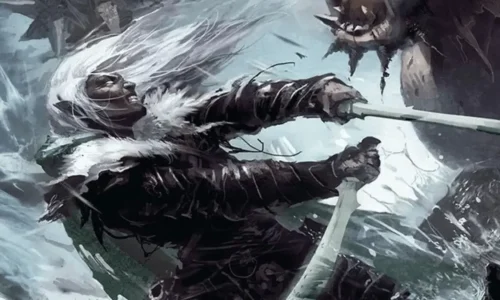The Bandit class in DnD 5e is a subclass of the Rogue class. Bandits are individuals who have chosen a life of crime, specializing in theft, ambushes, and illicit activities.
They excel in stealth, deception, and quick strikes, making them formidable adversaries and valuable allies. Bandits possess a unique skill set that allows them to infiltrate secure locations, disarm traps, and silently dispatch enemies.
They rely on their agility and nimbleness to navigate through dangerous situations and strike with precision. Additionally, their street smarts and knowledge of the criminal underworld make them adept at gathering information and manipulating others.
The Essence of Banditry
Banditry in D&D embodies rebellion, survival, and opportunism. Bandit characters reject societal norms, driven by personal motives like gain or vengeance. They navigate dangerous situations, outsmart adversaries, and adapt to elude authorities.
Playing a Bandit provides an alluring experience, allowing players to explore the thrill of rebellion and living by their own code. Stealth, subterfuge, and strategic planning are key as Bandits execute ambushes, heists, and covert operations.
The class offers diverse roleplaying options, including charming con artists, enigmatic spies, or brooding anti-heroes. Bandits often face internal conflicts, adding depth to their stories. Progression allows characters to grow from novice thieves to skilled infiltrators.
The Bandit class provides a unique combination of gameplay mechanics, roleplaying opportunities, and the freedom to challenge authority, making it a popular choice in DnD.
Tools of the Trade
Bandit in DnD 5e depends on a variety of signature weapons and equipment to excel in their illicit activities. Delving into these tools of the trade provides insights into the distinct gear that enhances Bandit gameplay and amplifies their abilities.
Light Weapons
Bandits favor light weapons that are easy to conceal and wield with finesse. Daggers, short swords, and rapiers are common choices, allowing Bandits to strike quickly and quietly. These weapons enable them to deliver deadly sneak attacks, exploiting vulnerabilities in their opponents.
Thieves’ Tools
A set of thieves’ tools is essential for any Bandit. These specialized instruments include picks, files, and small mirrors, enabling Bandits to pick locks, disarm traps, and gain entry to secured areas. Thieves’ tools are vital for successful heists, infiltrations, and covert operations.
Stealthy Armor
Bandits prefer light and flexible armor that doesn’t hinder their agility and stealth. Leather armor or studded leather provides some protection without compromising their ability to move silently and remain unseen.
This armor is often customized with hidden compartments to store stolen goods or extra tools.
Disguises and False Identities
Bandits often employ disguises and false identities to blend into various social environments. Masks, wigs, makeup kits, and sets of clothing help Bandits assume different personas, enabling them to gather information, manipulate others, or evade capture.
Climbing Gear
Bandits need to be adept at scaling walls, traversing rooftops, and accessing hard-to-reach places. Climbing gear, such as ropes, grappling hooks, and pitons, aid them in navigating vertical surfaces and bypassing obstacles.
Poison and Alchemical Substances
Bandits may dabble in the use of poisons and alchemical substances to incapacitate or eliminate their enemies. Poisoned daggers, sleep-inducing potions, or smoke bombs are tools that add an element of surprise and chaos to Bandit encounters.
Thrown Weapons
Bandits often rely on thrown weapons for ranged attacks and distractions. Throwing knives, darts, or shurikens can be concealed easily and used for surprise assaults or diversionary tactics, allowing Bandits to create opportunities or escape unfavorable situations.
Stolen or Concealed Goods
Bandits accumulate a variety of stolen goods and contraband, including valuable trinkets, stolen gold, counterfeit documents, and forbidden artifacts. These items can serve as bargaining tools, sources of income, or plot devices, adding depth and intrigue to Bandit storylines.
Subclass Specializations
Bandit in DnD has the opportunity to choose from different subclass options, each offering unique abilities and playstyles.
Let’s examine these subclass specializations, analyze their strengths, and weaknesses, and delve into the unique abilities they bring to Bandit characters.
Shadowblade Rogue
The Shadowblade Rogue subclass offers Bandits a deep dive into the world of shadow manipulation, infiltration techniques, and enhanced sneaking abilities. This subclass focuses on utilizing darkness and subterfuge to gain an edge over their enemies.
Strengths
- Shadow Manipulation: Shadowblade Rogues gain the ability to blend with shadows, becoming effectively invisible in dim light or darkness. This allows them to move undetected and launch surprise attacks on unsuspecting foes.
- Assassinate: Shadowblade Rogues excel at striking from the shadows. They gain an advantage on attack rolls against creatures that haven’t taken their turn in combat, increasing their chances of landing critical hits.
- Shadow Step: At higher levels, Shadowblade Rogues can teleport between shadows, swiftly traversing the battlefield and appearing in unexpected locations. This ability enhances their mobility and provides strategic positioning advantages.
Weaknesses
- Reliance on Darkness: Shadowblade Rogues heavily depend on dim light or darkness to activate their abilities. In brightly lit environments, their effectiveness may be reduced, and they may need to rely more on their general rogue skills.
- Limited Utility in Bright Environments: Their focus on shadows and darkness means that in well-lit areas, they might struggle to find advantageous positions or remain hidden.
Unique Abilities
- Umbral Sight: Shadowblade Rogues gain the ability to see perfectly in darkness, even magical darkness. This grants them a significant advantage when operating in dimly lit or shadowy environments.
- Shadowblade: As a Shadowblade Rogue, they can manifest a weapon made of solidified shadow. This weapon deals with psychic damage and provides a versatile tool for both stealthy and combat situations.
Swashbuckler
The Swashbuckler subclass embodies the charismatic and flamboyant nature of Bandits. Swashbucklers excel in flashy combat maneuvers, charm-based abilities, and dueling proficiency.
Strengths
Fancy Footwork: Swashbucklers are skilled in hit-and-run tactics. After making a melee attack against a creature, they can move away without provoking opportunity attacks, allowing them to engage enemies strategically and maintain mobility on the battlefield.
Rakish Audacity: Swashbucklers gain the ability to add their Charisma modifier to their initiative rolls, making them more likely to act quickly in combat. Additionally, if they engage in one-on-one combat, they gain Sneak Attack even if there are no allies adjacent to the target.
Panache: Swashbucklers possess a natural charm and charisma that can be used to their advantage. By engaging in witty banter and bravado during combat, they can divert an opponent’s attention, grant a disadvantage on attack rolls, and create opportunities for their allies.
Weaknesses
Reliance on One-on-One Combat: The Swashbuckler’s abilities are most effective in one-on-one engagements. In larger battles or situations where they can’t isolate a single opponent, their strengths may be less pronounced.
Lack of Defensive Abilities: Swashbucklers excel in offensive maneuvers and mobility but may have fewer defensive capabilities compared to other subclasses.
Unique Abilities
Panache: Swashbucklers gain the ability to charm opponents with their charismatic presence, compelling them to engage in one-on-one combat and granting themselves an advantage in social interactions.
Elegant Maneuver: At higher levels, Swashbucklers can use their bonus action to gain increased mobility and a bonus to their AC against opportunity attacks, allowing them to dance through combat unscathed.
Skirmisher
The Skirmisher subclass is an excellent choice for Bandits who excel in hit-and-run tactics, rely on mobility-enhancing skills, and possess expertise in wilderness survival. This subclass allows Bandits to navigate the battlefield with agility and strike their enemies swiftly before fading into the shadows.
Strengths
Hit-and-Run Tactics: Skirmishers are adept at engaging their foes quickly and retreating just as swiftly. They gain the ability to move half their speed as a reaction when an enemy ends their turn within 5 feet, allowing them to strike and withdraw before retaliation.
Skirmisher’s Stealth: Skirmishers have an innate talent for remaining hidden during combat. They gain an advantage on Dexterity (Stealth) checks while in combat, making it easier for them to remain unseen and move stealthily between attacks.
Survivalist Expertise: Skirmishers possess proficiency in the Survival skill, allowing them to navigate and survive in wilderness environments. They can track creatures, forage for food, and locate sources of water, making them invaluable in outdoor adventures.
Weaknesses
Limited Frontline Durability: Skirmishers are not built for prolonged engagements or absorbing heavy hits. Their focus on hit-and-run tactics means they may struggle if cornered or forced into prolonged melee combat.
Reliance on Open Spaces: Skirmishers perform best in environments that provide ample room for maneuvering and retreating. Confined spaces or areas with limited mobility options may restrict their effectiveness.
Unique Abilities
Skirmisher’s Stealth: Skirmishers gain the ability to take the Hide action as a bonus action on their turn, further enhancing their ability to remain unseen and strike from advantageous positions.
Sudden Strike: Skirmishers can make an additional weapon attack against a creature they hit with an attack on their turn, further increasing their damage output during hit-and-run assaults.
Multiclassing Options
Multiclassing offers Bandit in DnD the opportunity to combine the abilities and features of multiple classes, allowing for a more diverse and versatile character.
Here are some popular multiclassing options that can enhance the abilities of a Bandit in DnD:
Rogue/Warlock
Combining the Rogue and Warlock classes can create a character with potent spellcasting abilities and increased versatility.
Warlock spells can add utility, such as the ability to cast darkness or charm enemies, while Rogue abilities like Sneak Attack can still be utilized for devastating melee strikes.
Rogue/Fighter
Multiclassing as a Fighter grants a Bandit access to martial weapon proficiency, heavy armor, and additional combat abilities.
The Fighter’s Action Surge provides extra attacks, while the Battle Master archetype offers combat maneuvers that can further enhance a Bandit’s tactical options.
Rogue/Bard
A multiclass combination of Rogue and Bard allows for a charismatic and versatile character. Bards provide spellcasting capabilities, support abilities, and a wide range of skills.
This combination can enhance a Bandit’s social manipulation, infiltration, and versatility outside of combat.
Rogue/Ranger
Multiclassing as a Ranger can complement a Bandit’s wilderness survival skills and grant access to nature-based abilities.
The Ranger’s favored enemy and natural explorer features can enhance tracking and exploration, while the Hunter archetype provides additional combat options and utility.
Rogue/Druid
A Rogue/Druid multiclass creates a unique combination of stealth, nature magic, and shape-shifting abilities. Druid spells and Wild Shape can enhance a Bandit’s versatility and provide additional options for scouting, infiltration, and nature-based tactics.
Notorious Bandits in Lore
Throughout the lore of DnD, there are tales of a legendary bandit who has left their mark on the world. These infamous figures have become icons of cunning, skill, and audacity. Here are a few Notorious bandits from DnD lore:
Black Fang
Black Fang is a legendary Bandit Lord known for his ruthlessness and strategic brilliance in DnD. He led a fearsome band of thieves who terrorized the countryside, robbing caravans, pillaging villages, and evading capture.
Black Fang was said to possess an uncanny ability to blend into shadows and disappear without a trace, making him a formidable adversary.
Isabella the Shadowblade
Isabella the Shadowblade was a master assassin and Bandit Queen who operated in the shadows, targeting wealthy nobles and corrupt officials. She was known for her silent kills, using poisoned blades and hidden traps to dispatch her enemies.
Isabella’s reputation as a skilled infiltrator and her ability to manipulate darkness earned her a place among the most feared bandits in the land.
Red-Eyed Roderick
Red-Eyed Roderick was a charismatic and enigmatic bandit who led a gang of cutthroats known as the Red Wolves in DnD. He was renowned for his silver tongue and cunning, often using charm and deception to manipulate both allies and enemies.
Roderick’s signature red eyes were said to possess a mesmerizing power that allowed him to sway the minds of those who looked into them.
Scarlet Rose
Scarlet Rose was a bandit queen who operated in the dense forests and treacherous mountains. She was known for her expert archery skills, leading a band of skilled archers who struck with deadly precision.
Scarlet Rose’s audacity and tactical brilliance in ambushes and guerrilla warfare made her a formidable opponent and a symbol of rebellion against oppressive regimes.
Captain Flint
Captain Flint was a notorious pirate and bandit who ruled the high seas with an iron fist. He commanded a crew of cutthroats and plundered merchant ships, leaving destruction in his wake.
Flint was feared for his mastery of naval tactics and his ability to outmaneuver and outgun opposing forces. His legendary treasure hoard remains a tantalizing mystery, drawing adventurers to seek out his hidden lair.
Bandit Code
Bandit in DnD often operates by a set of unwritten rules and principles known as the Bandit’s Code. While individual bandits may have their own variations, there are common themes that define this code of conduct. Here are some key principles that embody the Bandit’s Code:
Loyalty Among Thieves
Bandits prioritize loyalty to their fellow outlaws. They value the bonds of their gang or crew and uphold a sense of camaraderie and trust. Betrayal is seen as a grave offense and is often met with harsh consequences.
Honor Among Enemies
Bandits, despite their criminal nature, often adhere to a sense of honor when dealing with adversaries. They may have rules against targeting the defenseless, stealing from the poor, or harming innocent civilians. This distinguishes them from mere common criminals.
Redistribution of Wealth
Many bandits justify their actions by embracing the idea of redistributing wealth. They often target the wealthy and corrupt, stealing from those who have amassed fortunes through exploitation or unjust means.
They may view themselves as champions of the oppressed and seek to level the playing field.
Respect for Skill and Cunning
Bandits admire skill, cunning, and audacity. They respect those who can outwit and outmaneuver their opponents, and they value individuals who demonstrate exceptional abilities in thievery, combat, or deception. Bandits often engage in friendly competitions to showcase their prowess.
Sanctuary and Hospitality
Bandits often provide shelter and refuge to fellow outlaws in need. They maintain secret hideouts, safe houses, or hidden camps where fellow bandits can find safety, rest, and respite from pursuing authorities.
This network of support fosters a sense of unity and shared purpose.
Discretion and Secrecy
Bandits understand the importance of secrecy to protect themselves and their operations. They maintain a code of silence, keeping their activities hidden from authorities and potential informants. Breaching this code can lead to severe consequences.
Independence and Freedom
Bandits cherish their independence and freedom from the constraints of societal norms. They embrace a life of adventure, avoiding the confines of settled life and the rules imposed by authority figures.
Bandits often reject the notion of being bound by laws that they see as oppressive or unjust.








